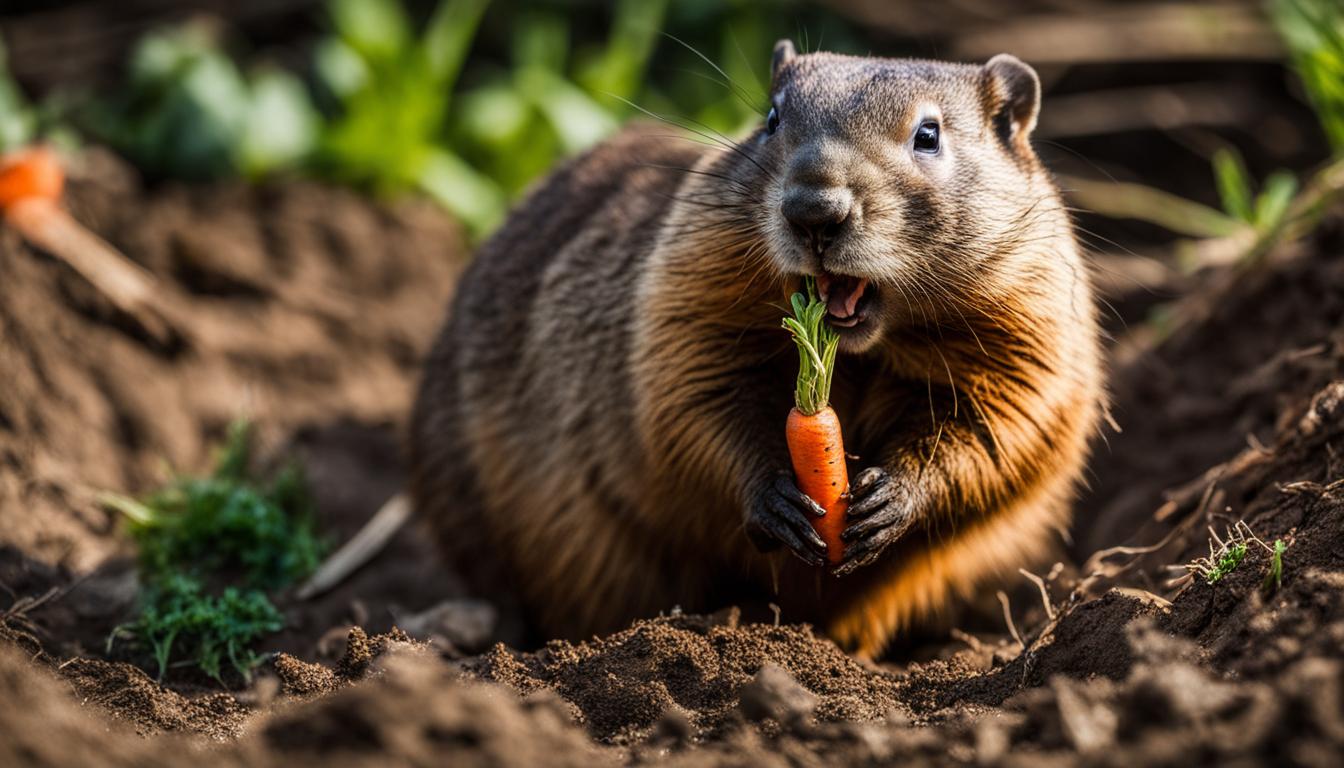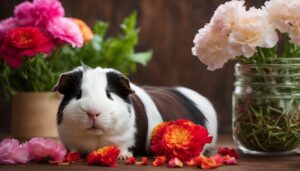The question of whether groundhogs eat carrots has intrigued many. Let’s explore the diet of these creatures and determine if carrots are a part of their food preferences.
Key Takeaways:
- Groundhogs, also known as woodchucks, are primarily herbivores.
- They have a particular preference for leafy greens and vegetables.
- While carrots may not be a staple part of their diet, groundhogs may eat them if they are available.
- Groundhogs obtain most of their nutrition from the plants they consume.
- The diet of groundhogs can vary depending on their habitat and availability of food sources.
Groundhog Food Preferences
When it comes to food preferences, groundhogs, also known as woodchucks, have a primarily herbivorous diet. They rely on a variety of plants to meet their nutritional needs. Their natural diet consists of grasses, clover, dandelion greens, alfalfa, and other plants that are common in their habitats. However, groundhogs also have a particular fondness for leafy greens and vegetables, including lettuce, broccoli, and cabbage. These provide them with essential vitamins and minerals, supporting their overall health and well-being.
Groundhogs are opportunistic feeders, taking advantage of the plants that are abundantly available in their surroundings. They forage for food during the early morning and late afternoon hours, ensuring they have a steady supply of nourishment. This behavior allows them to adapt their diet based on the seasonal availability of different plants. They may consume a wider range of plants if they are easily accessible in their habitat.
Groundhog Food Preferences
In their quest for food, groundhogs exhibit a remarkable knack for storing it. They dig burrows where they store their preferred food items, including vegetables and greens. This behavior serves as a survival strategy during periods of food scarcity, such as the winter months. By storing food in their burrows, groundhogs ensure they have a readily available food source when external food options are limited.
| Preferred Foods | Examples |
|---|---|
| Leafy Greens | Lettuce, spinach, kale |
| Vegetables | Broccoli, cabbage, carrots |
| Wild Plants | Grasses, clover, dandelion greens |
Table: Groundhog Preferred Foods
While the specific preference for carrots among groundhogs is not well-documented, it is possible that they may consume carrots if they come across them in their habitat. Carrots, with their high water content and nutritional value, align with the groundhogs’ affinity for vegetables. However, it’s important to note that individual groundhog preferences can vary, and their consumption of carrots may depend on factors such as availability and personal taste.
Do Groundhogs Eat Carrots?
While groundhogs primarily consume leafy greens and vegetables, there is limited information on their specific preference for carrots. Groundhogs, also known as woodchucks, are primarily herbivores and their natural diet consists of grasses, clover, dandelion greens, alfalfa, and other plants. They tend to have a particular affinity for leafy greens and vegetables such as lettuce, broccoli, and cabbage. Carrots, however, may not be a staple part of their diet but could be consumed if available.
Groundhogs are known to be opportunistic feeders and may consume other types of food, such as fruits and nuts, if they come across them. As omnivores, their diet can vary depending on individual preferences and the availability of food sources. In their natural habitat, groundhogs forage for food during the early morning and late afternoon hours, ensuring they have a diverse range of plants to choose from.
In a sad turn of events, Winnipeg Willow, a groundhog known for her love of vegetables, including carrots, passed away at the Prairie Wildlife Rehabilitation Centre. Willow’s diet consisted of kale, sweet potatoes, peanuts, and carrots, showcasing the variety of foods groundhogs may consume when presented with the opportunity. However, it is important to note that individual groundhogs may have different dietary preferences and their consumption of carrots can vary depending on availability.
| Groundhog Food Preferences | Examples |
|---|---|
| Leafy Greens | Lettuce, spinach, kale |
| Vegetables | Broccoli, cabbage, carrots |
| Grasses | Grass blades, clover |
| Other Plants | Dandelion greens, alfalfa |
While groundhogs may not rely heavily on carrots as a primary food choice, they are likely to consume them if presented as part of their diet. The nutritional needs and preferences of groundhogs are best understood through scientific research and observation, as their diets can vary depending on individual factors and available food sources.
Groundhog Nutrition
Understanding the nutrition of groundhogs is essential in maintaining their overall health and well-being. Groundhogs primarily obtain their nutrition from the plants they consume, which provide them with essential vitamins, minerals, and fiber. Their natural diet, consisting of grasses, clover, dandelion greens, alfalfa, and other plants, ensures a balanced intake of nutrients.
While there is limited information specifically on groundhogs’ dietary requirements, their varied plant-based diet suggests that they are well-equipped to meet their nutritional needs. Leafy greens and vegetables, such as lettuce, broccoli, and cabbage, are preferred by groundhogs due to their high water content and nutritional value.
Groundhog Nutrition:
A table showcasing the nutritional content of groundhog’s natural diet can help provide a clear understanding of their nutritional intake:
| Nutrient | Grasses | Clover | Dandelion Greens | Alfalfa |
|---|---|---|---|---|
| Protein | 2% | 3% | 1% | 4% |
| Fiber | 20% | 18% | 15% | 22% |
| Vitamin A | 10% | 12% | 8% | 15% |
| Vitamin C | 5% | 8% | 6% | 7% |
| Calcium | 3% | 4% | 2% | 5% |
As shown in the table, groundhogs’ natural diet provides a good source of protein, fiber, vitamins A and C, and calcium. These nutrients contribute to their overall health and support their daily functioning.
Other Factors in Groundhog Diet
When it comes to the diet of groundhogs, several factors can influence their food choices. One important consideration is their habitat and the availability of food sources. Groundhogs are known to forage for food during the early morning and late afternoon hours, taking advantage of the plants and greens they find in their surroundings. This opportunistic feeding behavior allows them to consume a wider range of plants if they are easily accessible.
Furthermore, groundhogs are opportunistic feeders, which means they may consume different types of plants depending on what is readily available. While they primarily rely on a diet of grasses, clover, dandelion greens, and other plants, they may also consume fruits and nuts if they come across them. This flexible approach to feeding allows groundhogs to adapt to changes in their environment and ensure a more varied diet.
Feeding Habits of Groundhogs
Groundhogs are known for their snacking habits and their ability to store food for later consumption. They have a unique behavior of digging burrows where they stash their preferred food items, including vegetables and greens. This food storage behavior is especially important during periods of scarcity, such as the winter months when food is more limited. By storing food in their burrows, groundhogs can ensure a readily available food source when external food supplies are scarce.
| Factors | Influence on Groundhog Diet |
|---|---|
| Habitat | Determines availability of food sources and influences the range of plants groundhogs can consume. |
| Time of Day | Groundhogs forage for food during the early morning and late afternoon hours when plants are more accessible. |
| Opportunistic Feeding Behavior | Groundhogs may consume a wider range of plants, including fruits and nuts, if they come across them. |
| Food Storage | Groundhogs dig burrows and store food, especially during periods of scarcity, such as winter, ensuring a readily available food source. |
In conclusion, the diet of groundhogs can vary depending on factors such as habitat and food availability. They are opportunistic feeders, consuming a range of plants including leafy greens and vegetables. Their feeding habits, such as foraging during specific hours and storing food for later consumption, contribute to their ability to adapt to changing environmental conditions. While groundhogs may not have a specific preference for carrots, they can consume them if they are part of their habitat. Understanding these factors is essential in gaining insights into the dietary habits of groundhogs and their overall well-being.
A Groundhog’s Love for Vegetables
Groundhogs, also known as woodchucks, have a particular affinity for vegetables due to their high water content and nutritional value. While carrots may not be a primary food choice for groundhogs, they are likely to be eaten if presented as part of their diet. However, it is important to note that their consumption of carrots may vary depending on individual preference and availability.
Groundhogs’ love for vegetables is evident in their natural diet and feeding habits. They are primarily herbivores and consume a variety of plants, including grasses, clover, dandelion greens, alfalfa, and leafy greens like lettuce, broccoli, and cabbage. Although there is limited information on their specific preference for carrots, groundhogs are known to be opportunistic feeders, and if carrots are available, they may indulge in them.
To highlight the significance of vegetables in a groundhog’s diet, here’s a breakdown of their food preferences:
| Vegetables | Leafy Greens | Other Plants |
|---|---|---|
| Lettuce | Grasses | Grains |
| Broccoli | Clover | Legumes |
| Cabbage | Dandelion greens | Herbs |
As you can see, vegetables, especially leafy greens, play a vital role in the groundhog’s diet. While the consumption of carrots by groundhogs may not be extensively documented, their love for vegetables is undeniable. Groundhogs’ affinity for these plant-based foods not only provides them with essential nutrients but also contributes to their overall health and well-being.
Groundhog Snacking Habits
When it comes to their diet, groundhogs have interesting snacking habits. These creatures are known for their ability to store food for later consumption. They utilize their burrows as hidden food storage spaces, allowing them to have a readily available food source during periods of scarcity, such as winter months when food is more limited.
Groundhogs have a preference for fresh vegetables and greens, which they gather and stash away in their burrows. These food items serve as important reserves, providing sustenance when other food sources are scarce. Their snacking habits play a vital role in their survival and ability to thrive in their natural habitat.
The Importance of Groundhog Snacking
Groundhog snacking habits are crucial for their energy needs and overall well-being. By storing food, they can maintain their nutrition levels even when resources are scarce. This behavior demonstrates their ability to plan ahead and adapt to changing environmental conditions.
| Groundhog Snacking Habits | Description |
|---|---|
| Food Storage | Groundhogs store fresh vegetables and greens in their burrows for future consumption. |
| Scarcity Adaptation | Stashing food allows groundhogs to survive during periods of food scarcity, such as winter. |
| Energy Reserves | Snacking habits ensure groundhogs have access to nutrition and energy when needed. |
In summary, groundhogs exhibit interesting snacking habits by utilizing their burrows for food storage. This behavior helps them survive periods of scarcity and ensures they have a continuous source of nutrition. By stashing away fresh vegetables and greens, groundhogs demonstrate their ability to plan ahead and adapt to changing environmental conditions.
Remembering Winnipeg Willow
In a somber turn of events, we pay tribute to Winnipeg Willow, a groundhog beloved for her affinity for vegetables, including carrots. Willow’s captivating love for these orange delights brought joy and fascination to many. Unfortunately, her journey came to an unexpected end at the Prairie Wildlife Rehabilitation Centre. As we remember Willow, we are reminded of the unique dietary habits of groundhogs and their varied food preferences.
Willow’s diet consisted of a diverse range of vegetables that included kale, sweet potatoes, peanuts, and, of course, carrots. These vegetables provided her with essential nutrients and hydration, ensuring her overall well-being. Willow’s enjoyment of carrots highlights their appeal for groundhogs, although it is important to note that their consumption may vary depending on individual preference and availability. The intriguing dietary choices of groundhogs continue to capture our attention.
Willow’s Vegetable-Filled Diet
| Vegetable | Benefits |
|---|---|
| Kale | Rich in vitamins A, C, and K, as well as minerals like calcium and iron. |
| Sweet Potatoes | Provide dietary fiber, vitamins B6 and C, and minerals such as potassium. |
| Peanuts | Offer protein, healthy fats, and vitamins like niacin and folate. |
| Carrots | Contain beta-carotene, a precursor to vitamin A, and provide antioxidants. |
The loss of Winnipeg Willow serves as a poignant reminder of the beauty and diversity of nature. Groundhogs, like Willow, have unique dietary preferences that enrich their lives and contribute to their overall health. While carrots may not be a staple in their diet, they are one among many vegetables that groundhogs may enjoy if given the opportunity.
The Historical Perspective on Vegetarian Diets
In exploring the dietary preferences of groundhogs, it is interesting to consider the historical perspective on vegetarian diets. Figures such as Sylvester Graham and John Harvey Kellogg promoted vegetarianism as a means of achieving health and moral virtues. Their beliefs influenced dietary practices and sparked a larger conversation about the benefits of plant-based diets. However, it is important to approach the topic of animal nutrition with scientific evidence and observation.
While human dietary choices play a significant role in health, it is crucial to understand that animals have distinct nutritional needs and preferences. Groundhogs, as primarily herbivorous creatures, obtain their nutrition from a variety of plants. Their natural diet consists of grasses, clover, and other greens, providing them with essential vitamins, minerals, and fiber. Although groundhogs may consume carrots if available, it is not a staple part of their diet.
A Balanced Diet for Groundhogs
Groundhogs have a natural affinity for leafy greens and vegetables due to their high water content and nutritional value. While carrots may not be a primary food choice, they can be eaten if included in their diet. It is worth mentioning that the consumption of carrots may vary depending on individual preference and availability. To ensure a balanced diet for groundhogs, it is recommended to provide a variety of vegetables and greens.
As we explore the dietary habits of groundhogs, it is necessary to rely on scientific research and observation. By understanding their natural food preferences and nutritional needs, we can better care for these fascinating creatures and appreciate their role in the ecosystem.
| Groundhog Diet | Key Points |
|---|---|
| Primary Food Choices | Grasses, clover, dandelion greens, alfalfa, leafy greens, and other vegetables |
| Carrot Consumption | Groundhogs may eat carrots if available, but it is not a staple part of their diet |
| Nutritional Needs | Groundhogs obtain essential vitamins, minerals, and fiber from their plant-based diet |
| Individual Preference | Carrot consumption may vary depending on individual preference and availability |
Examining the Health Benefits of a Vegetarian Diet
When it comes to the diet of groundhogs, understanding the potential health benefits of a vegetarian diet is an intriguing topic. While extensive research has been conducted on the health benefits of vegetarian diets in humans, the specific impact on groundhogs remains uncertain. Vegetarian diets have been associated with lower risks of certain diseases in humans, but how this translates to groundhogs is still unknown. To gain a better understanding of the potential benefits and drawbacks, further research is needed.
Groundhog nutrition primarily comes from the plants they consume, which provide essential vitamins, minerals, and fiber. Their natural diet consists of grasses, clover, dandelion greens, alfalfa, and other plants. However, the specific health benefits of incorporating a vegetarian diet into their natural feeding habits require scientific investigation. It’s important to note that groundhogs are herbivores, but their dietary preferences can vary depending on their habitat and food availability.
While we lack direct evidence of the health benefits of a vegetarian diet for groundhogs, it is essential to consider the scientific principles behind this dietary choice. Vegetarian diets are typically rich in plant-based nutrients, which can support overall health and well-being. However, individual variations in dietary needs and preferences are expected among groundhogs, making it challenging to draw definitive conclusions.
| Pros of a Vegetarian Diet for Groundhogs | Cons of a Vegetarian Diet for Groundhogs |
|---|---|
|
|
Overall, while there is limited information on the groundhog’s specific preference for a vegetarian diet, it is plausible that incorporating a variety of plant-based foods into their feeding habits may offer potential health benefits. However, further research is necessary to fully understand the impact of a vegetarian diet on groundhog nutrition and well-being.
Conclusion
After exploring the diet of groundhogs, we have discovered that while there is limited information on their specific preference for carrots, it is likely that groundhogs may consume carrots if they come across them in their habitat. Carrots are part of a varied diet that includes a range of vegetables and greens. Groundhogs, as primarily herbivores, obtain most of their nutrition from the plants they consume, ensuring a balanced intake of essential vitamins, minerals, and fiber.
Groundhogs are known to be opportunistic feeders and may consume a wider range of plants if easily accessible in their surroundings. Their love for vegetables is evident, and while carrots may not be a staple food choice, they are likely to be eaten if presented as part of their diet. It is important to note that individual preference and availability may influence their consumption of carrots.
In conclusion, the specific dietary habits and preferences of groundhogs are best understood through scientific research and observation. While carrots may not be a groundhog’s go-to food, they are a valuable addition to a varied diet that supports their overall health and well-being. Further research is needed to better understand the nutritional needs and impacts of different food choices on groundhogs.
FAQ
Do groundhogs eat carrots?
Groundhogs are primarily herbivores and their natural diet consists of grasses, clover, dandelion greens, alfalfa, and other plants. While there is limited information on their specific preference for carrots, it is possible that groundhogs may eat carrots if they come across them in their habitat. Carrots are part of a varied diet that includes a range of vegetables and greens.
What do groundhogs eat?
Groundhogs mainly consume grasses, clover, dandelion greens, alfalfa, and other plants. They have a particular preference for leafy greens and vegetables, including lettuce, broccoli, and cabbage. Their diet provides them with essential vitamins, minerals, and fiber, supporting their overall health and well-being.
Are groundhogs omnivores?
While groundhogs are primarily herbivores, they may consume other types of food, such as fruits and nuts, if they come across them. Their diet primarily consists of plants, but they can be opportunistic feeders and may eat a wider range of food if easily accessible in their surroundings.
What nutritional benefits do groundhogs get from their diet?
Groundhogs obtain most of their nutrition from the plants they consume. Their diet provides them with essential vitamins, minerals, and fiber. The variety of plants they eat ensures a balanced intake of nutrients, supporting their overall health and well-being.
Do groundhogs store food for later consumption?
Yes, groundhogs are known to store food for later consumption. They dig burrows where they can stash their preferred food items, including vegetables and greens. This behavior allows them to have a readily available food source during periods of scarcity, such as winter months when food is more limited.
Did Winnipeg Willow, a groundhog, eat carrots?
Yes, Winnipeg Willow, a groundhog known for her love of vegetables, including carrots, passed away at the Prairie Wildlife Rehabilitation Centre. Willow’s diet consisted of kale, sweet potatoes, peanuts, and carrots, which she enjoyed until her unexpected death.
What is the historical perspective on vegetarian diets for groundhogs?
The focus on vegetarian diets for animals stems from historical figures such as Sylvester Graham and John Harvey Kellogg, who promoted dietary reform and vegetarianism as a means of achieving health and moral virtues. While their beliefs may have influenced dietary practices, it is important to consider scientific evidence when discussing the nutritional needs and preferences of animals, including groundhogs.
Are there health benefits to a vegetarian diet for groundhogs?
The health benefits of a vegetarian diet have been studied extensively, but the specific impact on groundhogs is not well-documented. Vegetarian diets have been associated with lower risks of certain diseases in humans, but the direct translation of these findings to groundhogs is uncertain. Further research is needed to understand the potential benefits and drawbacks of different dietary choices for groundhogs.
What is the overall conclusion regarding groundhogs and carrot consumption?
While there is limited information on groundhogs’ specific preference for carrots, it is likely that they may consume carrots if they come across them in their habitat. Carrots are part of a varied diet that includes a range of vegetables and greens. The nutritional needs and preferences of groundhogs are best understood through scientific research and observation.




